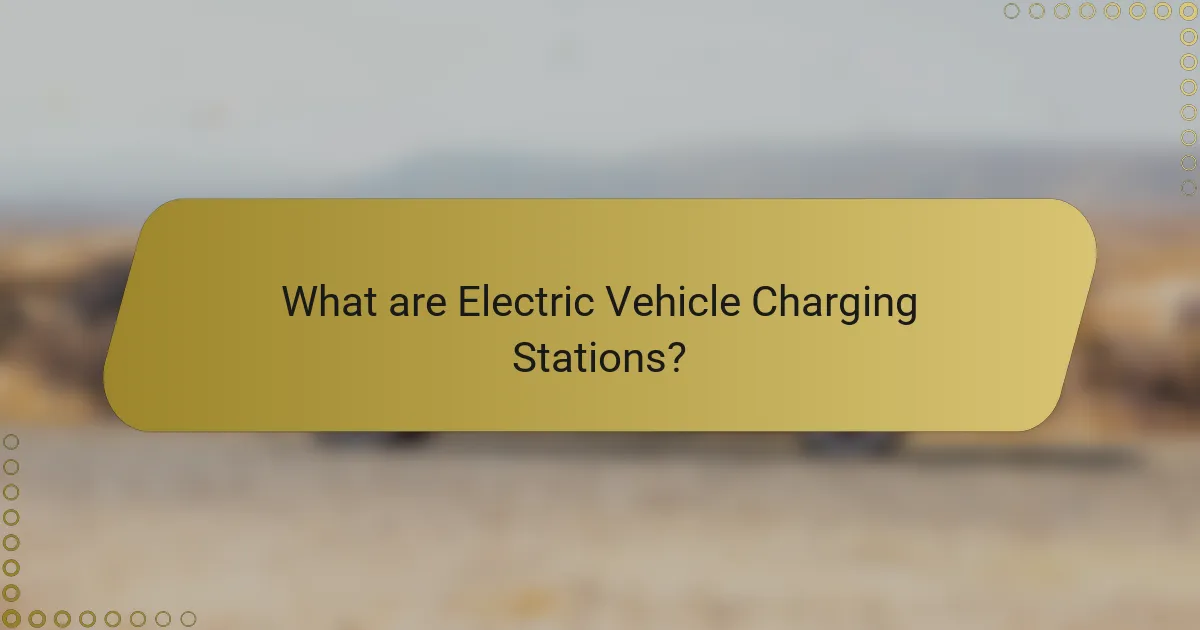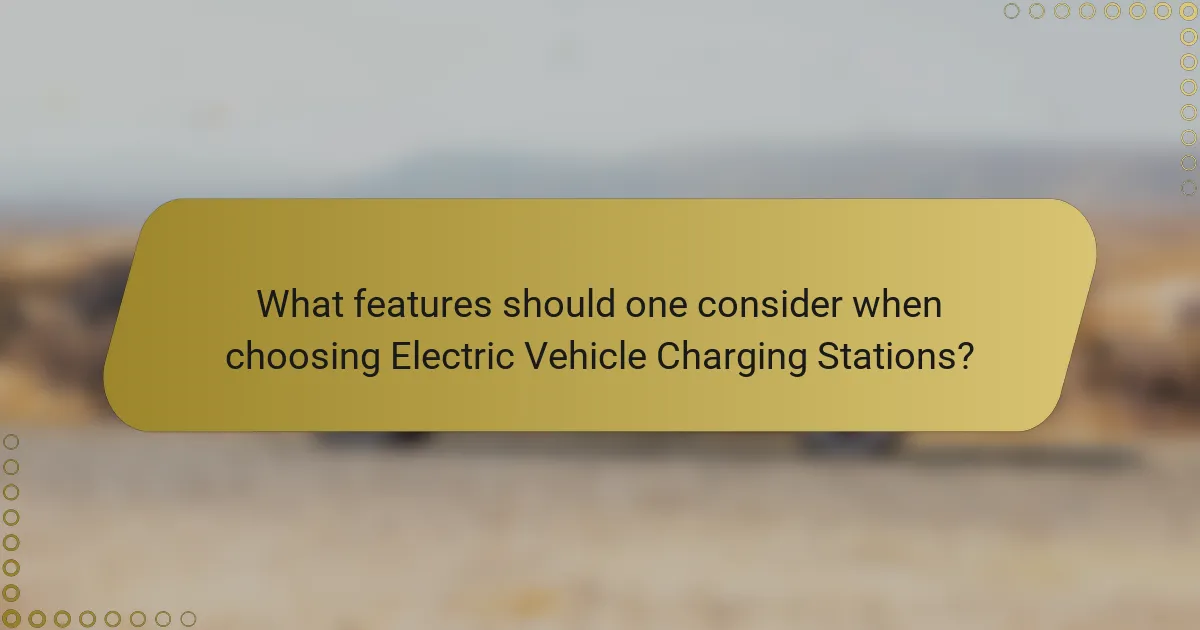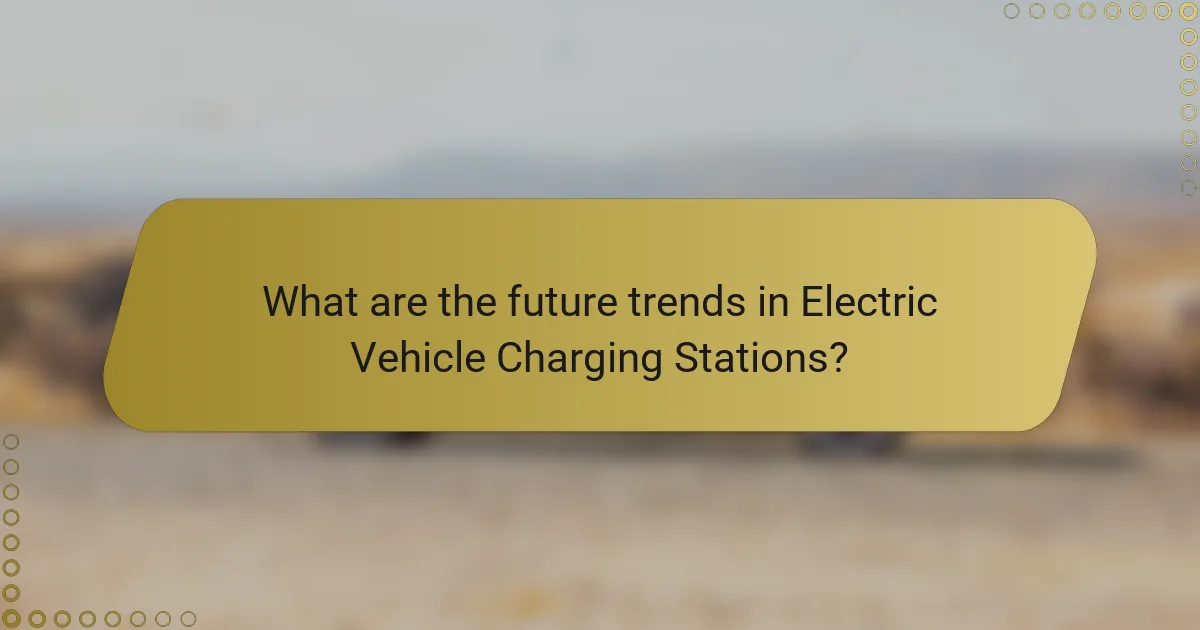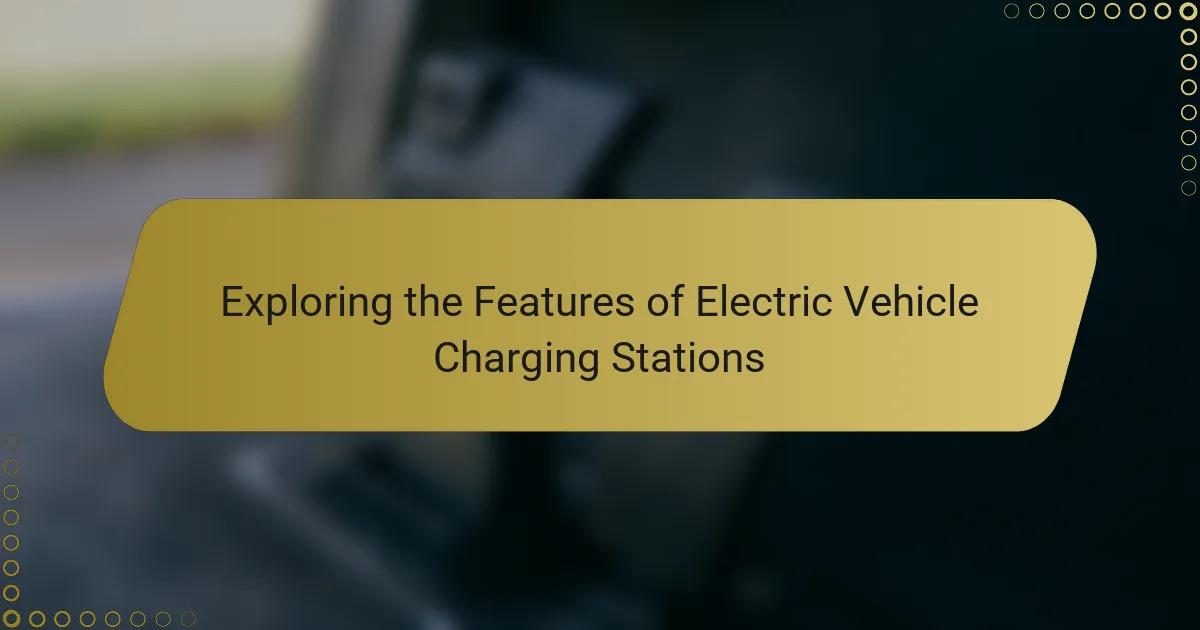Electric vehicle charging stations are facilities that provide electric energy for recharging electric vehicles (EVs), utilizing various charging standards such as Level 1, Level 2, and DC fast charging. The article outlines the characteristics and operational features of these stations, highlighting their increasing availability, with over 100,000 public stations in the U.S. as of 2023. Key considerations for users include charging speed, compatibility with specific EV models, location convenience, and payment options. Future trends indicate advancements in charging technology, integration with renewable energy, and the rise of mobile apps for locating and reserving charging stations, all supporting the growing adoption of electric vehicles globally.

What are Electric Vehicle Charging Stations?
Electric vehicle charging stations are facilities that provide electric energy for the recharging of electric vehicles (EVs). These stations typically supply power through various charging standards, including Level 1, Level 2, and DC fast charging. Level 1 chargers use a standard household outlet and are slower, usually providing 3-5 miles of range per hour. Level 2 chargers require a dedicated circuit and can deliver 10-60 miles of range per hour. DC fast chargers are designed for rapid charging and can provide up to 80% charge in 30 minutes or less.
The number of public charging stations has increased significantly, with over 100,000 stations available in the United States as of 2023. This expansion supports the growing adoption of electric vehicles, which reached over 2 million sales in the U.S. in 2021. Charging stations can be found in various locations, including parking lots, shopping centers, and along highways. They often feature payment systems that accept credit cards or mobile payments.
How do Electric Vehicle Charging Stations function?
Electric vehicle charging stations function by supplying electrical energy to recharge electric vehicles. They convert electrical energy from the grid into a form that can be utilized by electric vehicle batteries. Charging stations typically use either alternating current (AC) or direct current (DC) to facilitate this process.
AC charging stations often rely on onboard chargers within the vehicle to convert AC to DC for battery storage. DC fast charging stations bypass the vehicle’s onboard charger, supplying DC directly to the battery for quicker recharging.
The charging process begins when a vehicle is connected to the station via a charging cable. Communication occurs between the vehicle and the station to determine the appropriate charging rate and safety protocols.
Charging stations are equipped with safety features to prevent overcharging and ensure proper voltage levels. Most stations have user interfaces that display charging status and energy delivered.
In 2021, there were over 100,000 public charging stations in the U.S., highlighting the growing infrastructure supporting electric vehicles.
What are the key components of Electric Vehicle Charging Stations?
The key components of Electric Vehicle Charging Stations include the charging unit, power supply, connectivity features, and safety mechanisms. The charging unit is responsible for delivering electricity to the vehicle. It converts AC or DC power to the appropriate voltage and current for the vehicle’s battery. The power supply ensures a stable and adequate electrical input from the grid. Connectivity features enable communication between the charging station and the vehicle, often through protocols like CCS or CHAdeMO. Safety mechanisms include circuit breakers and emergency shutoff systems to prevent electrical hazards. These components work together to provide efficient and safe charging for electric vehicles.
How does the charging process work at these stations?
Electric vehicle charging stations work by supplying electrical energy to recharge the batteries of electric vehicles. The process begins when a vehicle is connected to the charging station using a compatible charging cable. The station then communicates with the vehicle to determine the appropriate charging parameters.
Next, the station delivers electricity at a specific voltage and current, which can vary based on the station type and vehicle requirements. For example, Level 2 stations typically provide 240 volts, while DC fast chargers can deliver up to 800 volts.
During charging, the vehicle’s onboard charger converts the incoming AC or DC power to the appropriate format for the battery. This process continues until the battery reaches its optimal charge level, which is usually around 80% for faster charging.
Finally, the charging station may automatically stop the flow of electricity once the battery is fully charged to prevent overcharging. This entire process is designed to be efficient and safe, ensuring that electric vehicles can be recharged effectively at various locations.
What types of Electric Vehicle Charging Stations exist?
There are three main types of electric vehicle charging stations: Level 1, Level 2, and DC Fast Charging. Level 1 charging stations use a standard 120-volt outlet. They provide a slow charge, typically adding 2 to 5 miles of range per hour. This type is suitable for home use and requires no special installation.
Level 2 charging stations operate on a 240-volt outlet. They offer a faster charging option, adding 10 to 60 miles of range per hour. This type is commonly found in public charging locations and requires professional installation.
DC Fast Charging stations provide rapid charging capabilities. They can charge an electric vehicle to 80% in about 30 minutes. This type is typically located along highways for long-distance travel. These three types cover various charging needs from home use to fast charging on the go.
What are the differences between Level 1, Level 2, and DC Fast Charging stations?
Level 1, Level 2, and DC Fast Charging stations differ primarily in charging speed and power output. Level 1 charging uses a standard 120-volt outlet. It typically provides 2 to 5 miles of range per hour. This makes it suitable for overnight charging at home. Level 2 charging operates at 240 volts. It delivers 10 to 60 miles of range per hour. This type is commonly found in public charging stations and can fully charge a vehicle in a few hours. DC Fast Charging, on the other hand, utilizes direct current and provides rapid charging. It can add 60 to 100 miles of range in just 20 minutes. This makes it ideal for long-distance travel. Each charging level serves different user needs based on charging time and location.
How do public and private charging stations vary in design and usage?
Public and private charging stations vary significantly in design and usage. Public charging stations are typically designed for high accessibility and are often located in areas such as parking lots, shopping centers, and highways. They generally feature multiple charging ports to accommodate various electric vehicles simultaneously. In contrast, private charging stations are usually installed at individual homes or businesses. Their design often prioritizes convenience for a single user and may include wall-mounted units or dedicated parking spaces.
Usage patterns also differ. Public stations are used by a broad range of drivers, often requiring payment through apps or credit cards. They are designed for quick charging, allowing users to recharge while running errands. Private stations, however, are used primarily by the owner of the vehicle, allowing for overnight charging at home, which is often more convenient and cost-effective.
According to a report by the International Energy Agency, public charging infrastructure is crucial for expanding electric vehicle adoption, whereas private charging solutions are essential for daily use. This highlights the complementary roles of both types of charging stations in supporting electric vehicle usage.
What are the benefits of using Electric Vehicle Charging Stations?
Electric vehicle charging stations provide several benefits. They enable convenient and accessible charging for electric vehicles. This convenience supports the growing adoption of electric vehicles. Charging stations often use renewable energy sources, reducing carbon footprints. They also contribute to lower operational costs for EV owners compared to gasoline. Many charging stations offer fast charging options, minimizing downtime. Additionally, the presence of charging stations can enhance property values in commercial areas. The expansion of charging infrastructure supports economic growth in the green technology sector.
How do these stations contribute to reducing carbon emissions?
Electric vehicle charging stations contribute to reducing carbon emissions by facilitating the use of electric vehicles (EVs). EVs produce zero tailpipe emissions, unlike traditional gasoline or diesel vehicles. By providing charging infrastructure, these stations encourage more drivers to switch from fossil fuel-powered vehicles to electric ones. A study by the International Council on Clean Transportation found that EVs can reduce greenhouse gas emissions by up to 70% compared to conventional vehicles, depending on the electricity source. Additionally, as renewable energy sources like solar and wind become more integrated into the grid, the carbon footprint of charging EVs continues to decrease. Thus, the proliferation of charging stations directly supports the transition to cleaner transportation.
What cost savings can users expect from utilizing Electric Vehicle Charging Stations?
Users can expect significant cost savings from utilizing Electric Vehicle Charging Stations. Charging an electric vehicle (EV) typically costs less than fueling a gasoline vehicle. For example, charging an EV can cost around $0.10 to $0.30 per kilowatt-hour. In contrast, gasoline prices can average between $3.00 to $4.00 per gallon.
Additionally, many public charging stations offer free charging or lower rates during off-peak hours. This can further reduce overall energy costs. According to the U.S. Department of Energy, electric vehicles can save owners an average of $800 to $1,000 annually on fuel compared to traditional vehicles.
In addition to fuel savings, EV owners may also benefit from tax credits and incentives. These can further enhance financial savings when purchasing or charging an electric vehicle. Overall, users can realize substantial financial benefits by switching to electric vehicle charging stations.

What features should one consider when choosing Electric Vehicle Charging Stations?
When choosing Electric Vehicle Charging Stations, consider the charging speed, compatibility, and location. Charging speed is crucial, as it determines how quickly your vehicle can recharge. Look for stations offering Level 2 or DC fast charging for faster refills. Compatibility with your vehicle’s charging port is essential to ensure functionality. Verify the station supports your specific EV model. Location matters for convenience; select stations near your frequent routes or destinations. Additionally, check for availability and reliability, as some stations may have downtime. User reviews can provide insights into the experience others have had with specific stations. Lastly, consider payment options; some stations require membership or app-based payments, while others accept credit cards.
What are the essential attributes of Electric Vehicle Charging Stations?
Electric Vehicle Charging Stations have several essential attributes. These include charging speed, connector types, and accessibility. Charging speed is measured in kilowatts (kW) and affects how quickly a vehicle can recharge. Common charging speeds are Level 1 (up to 2 kW), Level 2 (up to 22 kW), and DC fast charging (over 50 kW). Connector types vary, with the most common being Type 1, Type 2, and CCS. Accessibility refers to how easily users can reach and use the charging station. This includes physical location, signage, and user interface. Additional attributes may include payment options, network connectivity, and availability of real-time data. These attributes are crucial for ensuring a user-friendly charging experience.
How does charging speed impact user experience?
Charging speed significantly impacts user experience by influencing convenience and accessibility. Faster charging reduces wait times, allowing users to resume their journeys more quickly. This is particularly important for electric vehicle (EV) owners during long trips. A study by the International Council on Clean Transportation found that charging times can affect the overall satisfaction of EV users. Users prefer charging stations that offer rapid charging options. These stations can deliver up to 80% charge in about 30 minutes. In contrast, slower chargers can take several hours, leading to frustration. Therefore, optimal charging speed enhances user experience by providing efficiency and flexibility.
What safety features are critical in Electric Vehicle Charging Stations?
Critical safety features in Electric Vehicle Charging Stations include overcurrent protection, ground fault detection, and emergency stop buttons. Overcurrent protection prevents electrical overloads, reducing fire risks. Ground fault detection identifies leakage currents, ensuring user safety and preventing electric shocks. Emergency stop buttons allow immediate shutdown in emergencies, enhancing user control. Proper ventilation systems mitigate overheating risks during charging. User-friendly interfaces promote safe operation and clear instructions. Regular maintenance checks ensure all safety features function correctly, adhering to safety standards. These features collectively enhance the overall safety of Electric Vehicle Charging Stations.
How does location influence the effectiveness of Electric Vehicle Charging Stations?
Location significantly influences the effectiveness of Electric Vehicle Charging Stations. Proximity to high-traffic areas increases usage rates. Charging stations located near shopping centers or restaurants attract more drivers. Accessibility is crucial; stations should be easy to reach and navigate. Urban areas typically see higher demand due to population density. Conversely, rural locations may have fewer users, impacting station viability. Studies show that stations near major highways facilitate long-distance travel. Additionally, local policies and incentives can affect station placement and usage. Overall, strategic location enhances the utility and efficiency of charging stations.
What factors determine the best locations for charging stations?
The best locations for charging stations are determined by accessibility, traffic patterns, and proximity to amenities. Accessibility ensures that charging stations are easy to reach for electric vehicle users. High traffic areas increase the likelihood of usage, making them strategic locations. Proximity to amenities, such as shopping centers or restaurants, enhances the user experience while waiting for their vehicle to charge. Additionally, local regulations and incentives can influence site selection. Research indicates that stations near major highways see higher utilization rates, supporting the importance of location in charging station effectiveness.
How does accessibility affect user convenience at charging stations?
Accessibility directly enhances user convenience at charging stations. It ensures that all users, including those with disabilities, can easily locate and use charging facilities. Accessible charging stations typically feature designated parking spaces, appropriate signage, and user-friendly interfaces. These features reduce the time and effort required for all users to charge their vehicles. According to the U.S. Department of Transportation, accessible infrastructure can significantly improve the overall user experience. Enhanced accessibility can lead to increased adoption of electric vehicles, as convenience is a key factor in consumer decision-making.

What are the future trends in Electric Vehicle Charging Stations?
Future trends in electric vehicle charging stations include increased charging speed and accessibility. Fast charging technology is evolving, reducing charging times significantly. Ultra-fast chargers can deliver up to 350 kW, enabling a full charge in under 30 minutes.
Integration with renewable energy sources is also on the rise. Many stations are incorporating solar panels to generate clean energy on-site. Smart charging solutions are being developed to optimize energy usage based on grid demand.
Additionally, mobile apps for locating and reserving charging stations are gaining popularity. These apps enhance user convenience and streamline the charging process.
Lastly, the expansion of charging networks is expected to continue. More partnerships between automakers and charging providers are being formed to increase station availability. This trend supports the growing adoption of electric vehicles worldwide.
How are advancements in technology shaping Electric Vehicle Charging Stations?
Advancements in technology are significantly shaping Electric Vehicle Charging Stations. Innovations such as fast-charging capabilities reduce charging time from hours to minutes. Wireless charging technology eliminates the need for physical connectors, enhancing user convenience. Smart charging solutions enable users to monitor and control charging via mobile apps. Integration with renewable energy sources allows for sustainable charging options. Enhanced payment systems streamline transactions, making them more user-friendly. Real-time data analytics improve station management and efficiency. These advancements collectively enhance the user experience and promote the adoption of electric vehicles.
What role does renewable energy play in the future of charging stations?
Renewable energy will significantly enhance the sustainability of charging stations. It allows for the reduction of greenhouse gas emissions associated with electricity generation. Charging stations powered by solar or wind energy can operate with minimal environmental impact. In 2020, the International Energy Agency reported that renewable sources accounted for nearly 30% of global electricity generation. This trend is expected to grow, providing cleaner energy for electric vehicle charging. Integrating renewable energy into charging stations can also lead to cost savings over time. As technology advances, energy storage solutions will improve, making renewable energy more reliable for charging needs. This shift supports the transition to a low-carbon transportation system.
How might smart charging solutions evolve in the coming years?
Smart charging solutions are expected to evolve significantly in the coming years. Advancements in technology will enable more efficient energy management. Integration with renewable energy sources will increase, allowing for greener charging options. Enhanced connectivity will facilitate real-time communication between vehicles and charging stations. This will enable dynamic pricing models based on demand and grid conditions. User-friendly interfaces will improve the customer experience. Increased automation will streamline the charging process, making it more accessible. Data analytics will play a crucial role in optimizing charging patterns and infrastructure planning. These trends indicate a shift towards more sustainable and user-centric charging solutions.
What are some best practices for using Electric Vehicle Charging Stations?
To use Electric Vehicle Charging Stations effectively, follow these best practices. Always check the station’s compatibility with your vehicle. Ensure your vehicle supports the charging type available at the station. Familiarize yourself with the charging station’s payment methods. Many stations accept credit cards or mobile apps. Arrive with sufficient battery charge to avoid range anxiety. Monitor charging status through your vehicle or the station’s display. Be courteous and move your vehicle once charging is complete. This allows others to use the station. Lastly, report any issues with the station to the provider. This helps maintain the charging infrastructure.
How can users maximize the efficiency of their charging sessions?
Users can maximize the efficiency of their charging sessions by selecting optimal charging locations and times. Charging at stations with higher power outputs can significantly reduce charging duration. Utilizing smart charging features available in many electric vehicles can optimize energy use. Scheduling charging during off-peak hours can also lower costs and improve efficiency. Maintaining the vehicle’s battery health through regular checks ensures better performance during charging. Using the vehicle’s app to monitor charging status can help users manage sessions effectively. Research shows that charging at around 20% to 80% of battery capacity is most efficient. These practices lead to faster, cost-effective, and more effective charging sessions.
What common troubleshooting tips should users know for Electric Vehicle Charging Stations?
Check the connection to ensure it is secure. Loose connections can prevent charging. Verify the power supply is active. Sometimes, the outlet may not be functioning. Inspect the charging cable for any visible damage. A damaged cable can disrupt the charging process. Look for error messages on the charging station display. These messages can provide specific troubleshooting guidance. Restart the charging station if it has a reset option. This can resolve temporary glitches. Ensure the vehicle is compatible with the charging station type. Not all vehicles can use every charging station. If issues persist, contact customer support for assistance. They can provide further troubleshooting steps specific to the station.
Electric Vehicle Charging Stations are facilities designed to provide electrical energy for recharging electric vehicles (EVs) through various charging standards such as Level 1, Level 2, and DC fast charging. The article covers the functionality, key components, and types of charging stations, highlighting differences in charging speeds and designs for public versus private use. Additionally, it discusses the benefits of these stations, including cost savings and environmental impact, while addressing future trends and best practices for users. Essential attributes like charging speed, compatibility, and safety features are also examined to enhance user experience and support the growing adoption of electric vehicles.
